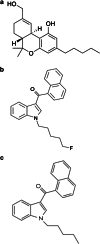High times, low sats: diffuse pulmonary infiltrates associated with chronic synthetic cannabinoid use
- PMID: 23539384
- PMCID: PMC3657026
- DOI: 10.1007/s13181-013-0288-9
High times, low sats: diffuse pulmonary infiltrates associated with chronic synthetic cannabinoid use
Abstract
Introduction: In recent years, cases of severe adverse effects from recreational use of synthetic cannabinoids (SC) have established that these agents represent a novel toxicologic hazard.
Case report: A 21-year-old male presenting as a vehicular trauma victim was noted with diffuse pulmonary infiltrates related to chronic inhalation of multiple synthetic cannabinoid-containing products. Chest imaging revealed bilateral, subacute lung infiltrates; histopathological analysis of bronchial and alveolar tissues revealed an inflammatory process. An extensive workup failed to identify infectious, malignant, autoimmune, or hematologic causes of the syndrome, and toxicological analysis of the blood and body fluids confirmed the presence of multiple synthetic cannabinoids and metabolites. The patient recovered after an 8-day ICU course, wherein he received antibiotics, steroids, and mechanical ventilation.
Discussion: This case contributes to the currently evolving knowledge about SC agents, adding a rarely described pulmonary complication to the growing list of adverse effects associated with these products.
Figures







References
-
- Vearrier D, Osterhoudt K (2010) A teenager with agitation: higher than she should have climbed. Ped Emerg Care 26(6):462-465 - PubMed
-
- Logan BK, Reinhold LE, Xu A, Diamond FX (2012) Identification of synthetic cannabinoids in herbal incense blends in the United States. J Forensic Sci 2012 Jul 26 - PubMed
Publication types
MeSH terms
Substances
LinkOut - more resources
Full Text Sources
Other Literature Sources
Medical

